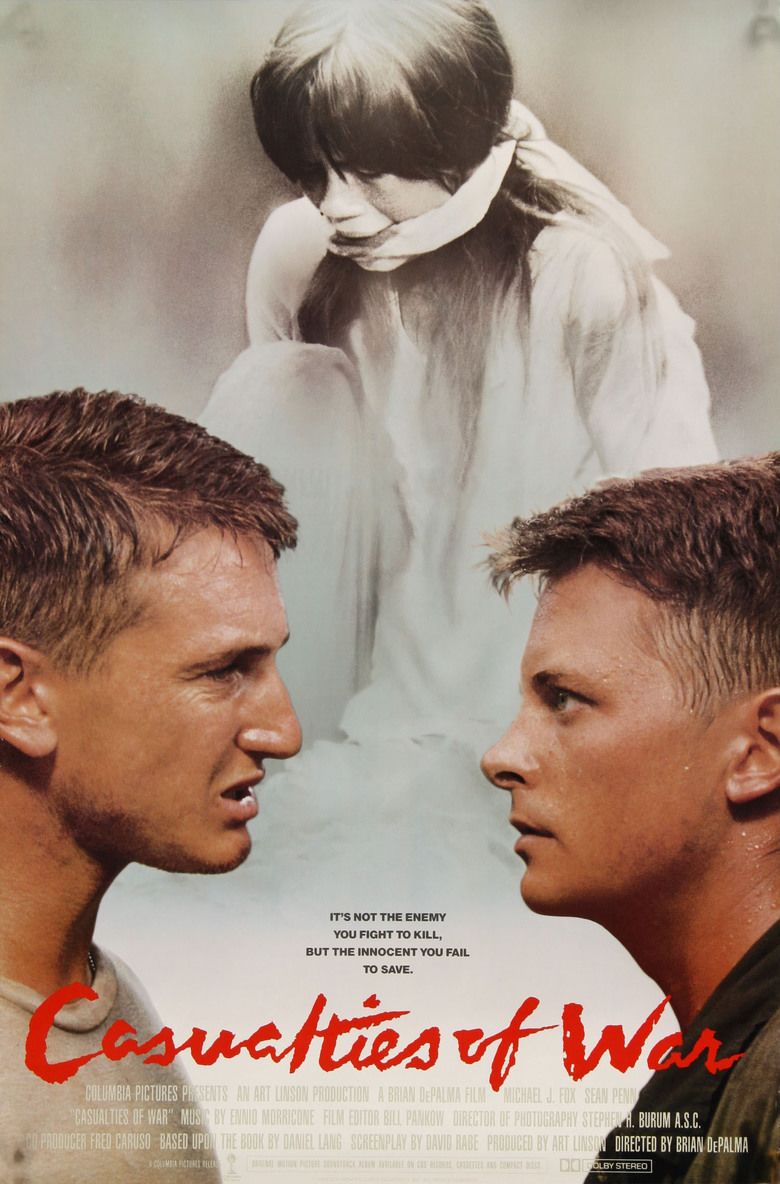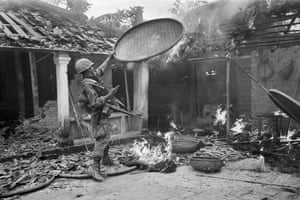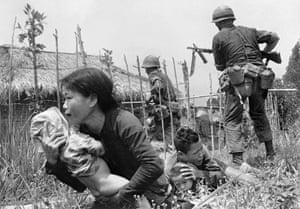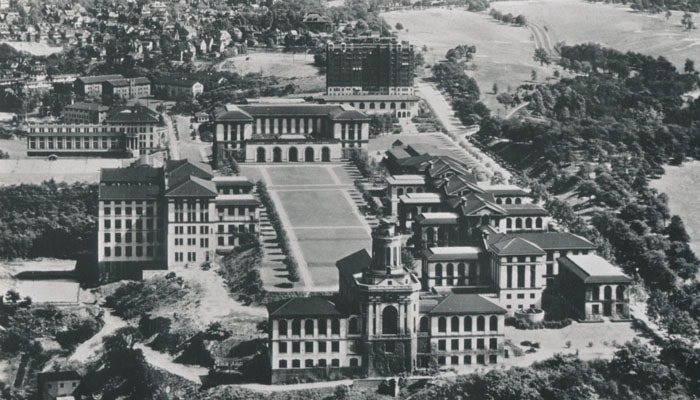Wednesday, May 17, 2017
History Final Film Research Project Post #5
The film, Casualties of War, portrays a story based on a primary source from a private in the military during the Vietnam War. The movie was created by a director named Brian De Palma to bring attention to a rape, kidnapping, and murder that was never publicized and really known across the United States. The full story of the incident that happened in Vietnam was never known until in 1969 a reporter named Daniel Lang released the full story, as told by Eriksson. Thirteen years after the report from Daniel Lang the movie was made, based off of the story of first hand accounts by Mr. Eriksson. While the movie does cover most of the real factual events of the story there was also some dramatization in some parts as to attract more attention and draw audience into the movie much like in the movie 12 Years a Slave. An example of something that was used to make the audience feel more and become more attached to private Eriksson was like how in the movie it was said that Eriksson had a wife as well as a daughter, even with a picture of his daughter, where as in reality the private only had his wife back home. Another instance where this happened was when early in the movie there was a character named Brownie who suffered from a gun wound and had to be evacuated to bring the audience in so that they didn't get bored with only historical content. The character Brownie was never referred to have existed in the story told by Private Eriksson to reporter Daniel Lang. As described by Vincent Canby in a New York Times movie review, each character played their part spectacularly. Micheal Fox playing the "conscious-stricken" Erikkson and Sean Penn playing the crafty Merserve with the others in the squad following his lead with unquestioned loyalty. A larger dramatization that occurred in the movie was when they were actually murdering the girl that they kidnapped. In the primary source it said that she was killed and disposed off, whereas in the movie it heavily dramatized the scene during a firefight over a railway. In the movie she got up after being stabbed, covered in blood, walking toward the soldiers only to be shot multiple times by Sgt. Meserve and the other members of the squad only to have her fall off of the railroad and ultimately die. It also showed when Eriksson tried to tell his commanding platoon leader the story of what happened and only having him talk down and say that what happens on the battlefield stays on the battlefield, trying to keep the instance of what happened from getting out. Nearing the end of the movie during the court martial scene it showed the men responsible for their crimes being sent to prison for their actions out in the field. This displays the climax of the movie showing the emotion of the men and ultimately ending with Eriksson achieving his goal to bring out the true story of what happened. Casualties of War much like 12 Years a Slave was more of a "work of art", and not "feel good" story. Brian De Palma, like many other history film makers, used the story told as a backdrop and was more interested in creating an emotional response from the audience while also telling a factual and important store.
Tuesday, May 16, 2017
Casualties of War Post #4
Casualties of War Research Project (4)
Works Cited
"Vietnam: The Real War – in Pictures." The Guardian. Guardian News and Media, 22 Apr. 2015. Web. 17 May 2017.
Bramen, Lisa. "Fishing With Grenades and Cooking With C4: A Veteran’s Vietnam Food Memories." Smithsonian.com. Smithsonian Institution, 10 Nov. 2010. Web. 17 May 2017.
Lang, Daniel. "Casualties of War." The New Yorker. The New Yorker, 08 May 2017. Web. 17 May 2017.
The New York Times. The New York Times, n.d. Web. 17 May 2017.
Causualties of War Post #2
Casualties of War Research Project (2)
Menu for the Hearing : (food soldiers would eat on the battlefield)
Each of these items on the menu are important for the soldiers survival during their missions in unfamiliar vietnamese territory. In some cases the soldiers would eat cold food as to not attract attention to themselves during the night from VC soldiers.
C Rations - Turkey Loaf, Lima Beans, Cookies
Fish - Obtained by throwing a hand grenade into the water and collecting the fish
Shrimp - Local South Vietnamese soldiers showed US soldiers how to catch shrimp
BBQed Snake - Soldiers sometimes caught them but were scared of the deadly ones
Rice Paddies - Soldiers sometimes would visit local vietnamese restaurants
Causaulties of War Post #1
Casualties of War Research Project (1)
Court Martial Hearing - Case #202
Theme : Military Court hearing consisting of actors involved as well as historians reporters
Hearing Description : On the date, May 17 2017, military personnel listed below are being brought in under accusations of a strict violation of the law. The military personnel involved were part of a reconnaissance patrol with the mission to comb a sector of the Central Highlands looking for Vietcong activity.
Violations: Kidnapping, rape, and murder of a vietnamese civilian
Guest List :
Micheal J. Fox (Private Eriksson, man who brought forth the accusations)
---------------------------------------------------------
Sean Penn (Sgt. Tony Meserve)
John Reilly (PFC Herbert Hatcher) Military personnel involved in the
Donald Harvey (Cpl. Thomas Clark) violations of kidnapping and rape
John Leguizamo (PFC Antonio Diaz)
---------------------------------------------------------
Phan Thi Mao (Victim of these men)
Daniel Lang (Reporter helped publicize the story and bring it out the true story)
Brian De Palma (American film director and screenwriter who produced Casualties of War)
Wednesday, April 19, 2017
WWI Poster Analyzing
Propaganda - A biased opinion to get attention of people for a cause
information, ideas, or rumors deliberately spreadwidely to help or harm a person, group,movement, institution, nation, etc.
http://www.dictionary.com/browse/propaganda
Poster #1 - A Wonderful Opportunity for You
In this poster it is trying to get the attention of people looking for new opportunity in life. It says "Ashore on leave" as someone that has their luggage is about to leave with the United States Navy as he has a big happy smile on his face.
Poster #2 - Learn to make and test the big guns
In this poster the artist is trying to get the attention of people interested in working with guns. It says "better yourself - enlist and learn new trade" trying to get the attention of people looking to learn a new trade in the "ordinance department.
Poster #3 - US Navy Recruiting Station
On this poster it is headlined, "The navy needs you! Don't read American history make it!" trying to encourage people to join the fight to make "their own American history". It has an angelic woman holding an American flag behind the soldier that is enlisting trying to get the attention of the men and encourage them to join.
information, ideas, or rumors deliberately spreadwidely to help or harm a person, group,movement, institution, nation, etc.
http://www.dictionary.com/browse/propaganda
Poster #1 - A Wonderful Opportunity for You
In this poster it is trying to get the attention of people looking for new opportunity in life. It says "Ashore on leave" as someone that has their luggage is about to leave with the United States Navy as he has a big happy smile on his face.
Poster #2 - Learn to make and test the big guns
In this poster the artist is trying to get the attention of people interested in working with guns. It says "better yourself - enlist and learn new trade" trying to get the attention of people looking to learn a new trade in the "ordinance department.
Poster #3 - US Navy Recruiting Station
On this poster it is headlined, "The navy needs you! Don't read American history make it!" trying to encourage people to join the fight to make "their own American history". It has an angelic woman holding an American flag behind the soldier that is enlisting trying to get the attention of the men and encourage them to join.
Thursday, April 13, 2017
Hawaiian: The Legend of Eddie Aikau Response
In the film, Hawaiian: The Legend of Eddie Aikau, a distinct view of a traditional native Hawaiian is given as the American 19th century imperialism shows its impact on Hawaii. Eddie Aikau grew up in a poor family and dropped out of his school to focus on what he loved most, surfing. Being in the water surfing is where he felt most at home and at peace. As he grows up he starts to see more and more white Americans coming into Hawaii, his home, and taking away the Hawaiians most traditional piece, surfing. The Americans pretty much dominated the island and dominated the North side of the island where the waves rose and highest with the best surfing conditions. As imperialism continued more Americans continued coming into Hawaii making the island their home as well along with the traditional Hawaiians that had lived on the island their whole lives. This film gives a deeper understanding of Imperialism by giving a first hand experience of someone who had lived in Hawaii his whole life along with his family to only watch as white Americans began flowing into their home to take it over and make it their own and adopt their ways as their own as well.

Thursday, April 6, 2017
How do you analyze a politcal cartoon?

https://s-media-cache-ak0.pinimg.com/originals/1e/8d/6c/1e8d6c9124bb03b7a9557ff247f9f9a5.jpg
In this cartoon about the Spanish American war it depicts the American army forcing the Spanish out of Cuba. I came to this conclusion by seeing McKinley releasing the "dog", which represents the army, that is chasing out a torn up soldier that represents the Spanish army.

https://sheg.stanford.edu/upload/Lessons/Unit%206_Gilded%20Age/PhilipineWar2.jpg
In this politcal cartoon the artist is depicting Asians leaving the Philippines while the Americans take over. I came to this conclusion by seeing the wall with a gate leading out of the Philippines looking out toward an Asian styled temple. The men leaving are carrying their stuff out and have on a hat that says Asia.
https://s-media-cache-ak0.pinimg.com/originals/1e/8d/6c/1e8d6c9124bb03b7a9557ff247f9f9a5.jpg
In this cartoon the artist is depicting that the Americans took Hawaii and saw it as an opportunity to take advantage of the sugar industry on the island. I came to this conclusion by looking at the Hawaiian princess on a see-saw being raised up by an American and farmer with a barrel of sugar in the middle of the see-saw.
Tuesday, March 21, 2017
Civil Rights Act of 1964 Classwork
After the passing of the Civil Rights Act in 1964 by Kennedy discrimination based on race, color, sex, religion, and national origin was all outlawed. It ended unequal voting applications as well as segregation in schools, as well as public work places getting rid of the commissioner of safety, Bull Connor. Discrimination is a hard force to abolish. Today there is still discrimination all around us due to different values of some people. The Klan, though smaller, still exists showing that discrimination is a hard force to fight. People raised by family members who were brought up knowing segregation and still discriminating are likely to have the same views as their parent. One way that can reduce discrimination is to make the people around us more aware that we are all human and the same on the inside and maybe get rid of the Klan entirely if possible.
On this field trip I am looking forward to seeing Birmingham and the church at which everything took place as well as imagining what the actual march looked like with thousands of people. I also hope to have a guide that actually was part of the march and can give some first hand knowledge of what it was like.

https://en.wikipedia.org/wiki/Civil_Rights_Act_of_1964
On this field trip I am looking forward to seeing Birmingham and the church at which everything took place as well as imagining what the actual march looked like with thousands of people. I also hope to have a guide that actually was part of the march and can give some first hand knowledge of what it was like.

https://en.wikipedia.org/wiki/Civil_Rights_Act_of_1964
Tuesday, February 28, 2017
HP corruption Newspaper blog post
Today in class I was asked to look at newspaper articles from the past and pick out an interesting topic to further look into. I chose to look at corruption, a common word in newspapers back then showing the state our country was in. I chose the date range 1880-1900 to see what I could find, what I found was actually really interesting. I look at a newspaper in NewYork called the Brooklyn Daily Eagle on an article titled Sources of National Corruption. In this article it talked about key examples of corruption in that specific day and time. It discussed the corruption of government that was taking place. Powerful moneyed classes and monopolies were able to use their wealth to corrupt the system of government in place, there was a corrupt use of money in elections as well as a corrupt use to secure positions in high ranked legislation. The government had a failure to punish robbery due to bribery. The theft of presidency in 1876 due to Grant's establishment of the 38th state. Continuing there as the wholesale corruption of voters discussed in this article suppressing popular will that took place in 1880. A constant corruption took place by government officeholders through frauds for their own personal welfare and money. As well as the everlasting corruption of monopolies of powered moneyed men with enough wealth to influence the government into corruption. All in all it was pretty interesting to see what kinds of corruption our nation has gone through since the beginning, all prospering nations experience corruption stated this article, giving Great Britain as an example. Like the US has today it has prospered through this corruption and become a strong nation just like the article predicted.
Tuesday, February 14, 2017
Temperance Movement Post
Today in the last portion of class I took the time to looks into the temperance movement of the late 19th century and early 20th century. The establishment of this law was to try and create a sober nation and expand education and business.
Thursday, February 9, 2017
Progressive Era Post HP
- How would you define “progress”?
- What period in time is referred to as the Progressive Era? Why? What types of issues and actions, and achievements are associated with the Progressive Era?
- Progressives had lots of goals. What do progressive reforms have in common?
- Evaluate the major goals of Progressives and sort them into these 4 categories: (Or make your own categories or ranking system), such as best to worst.
- Essential goals worth striving for/ Necessary changes
- Good Goals – not strictly necessary but could really improve life
- Strange Goals
- Not a good idea
1. Progress - How a group of people innovate and improve life
2. Progressive Era (1890-1920) It was a response to economical and social problems during the time. Began as a social movement and turned into political movement. Rejection to social Darwinism.
3. The saw providing a good education, a safe environment, and an efficient workplace as the way to improve the times.
4.
Essential Goals; Expose corporate greed, fight political corruption
Good Goals; provide good education, improve the workplace
Wednesday, February 8, 2017
History Future Research
- What predictions about the future were people making 100 years ago? 50 years ago? (Find 3-4 articles or discussions to look over.)
- Determine if the list is a “wish list” – as in, these are the things one might hope for in the future, or more a warning.
- Which predictions seem to have come true? Which turned out to be bizarre, off-track, or still out of reach?
- Can you identify any trends or patterns in these predictions? What concerns or achievements do they seem focused on? For example, do people in general seem to be anticipating a better world?
- It is your turn to predict a future world. What do you see?
1.
100 years
BBC(right) - Digital Color, Tanks, Americans growing in height, Mobile Phones, MREs, TV, Bigger Fruits
BBC(wrong) - Everybody will walk 10 miles a day, no more cars in big cities, no mosquitos or flies
WebUrbanist - Wild animals wont exist anymore except in zoos, food deliver via pneumatic tubes, zero traffic sound in cities
50 years
Urbanghostsmedia - Dolphins/Apes will be engineered to be more useful, printing new knowledge into the human brain, deep freezing, exploration to different galaxies, quantum generator, robot fighting and no more human war casualties, robot hospitals, online learning through TV, moon colonies
2. In some cases these lists are considered a wish list and in others they are considered a reality list. People predicting the future back in the day were either way to conservative or were making extreme unbelievable predications. In the BBC post a handful of the predictions made have become true today, whereas in some the ideas are completely farfetched and unrealistic in todays terms.
3. Predications like Americans growing in height, mobile phones, meals ready to eat, TV, bigger fruits, and color printing are all predications that have come true with the technology we have today. Ideas like food being delivered through pneumatic tubes, human brain imprinting, war robots, deep freezing, and moon colonies are all still out of reach in this century.
4. Theres a pattern of a better future in each list of predications, focused most importantly around the improvement of life and technology. In general people do anticipate a better world lying ahead of them, a world that opens opportunity and a better quality of life.
5. By 2100 I predict a great advancement in the technology that we have available, through scientific innovations we will have much more advanced transportation. Flying cars, a higher ability to travel to space and possible establish a colony on the moon, and human brain chip implants.
Friday, February 3, 2017
Urbanization, Industrialization, and Philanthropy
Harrison Pearson
2/3/17
Urbanization In-Class Essay
The late nineteenth century was a time of growth and tremendous industrial as well technological change for the world on a global scale. Each year there were new innovative inventions that changed the very nature and quality of life. In America it was considered a time of both crisis and opportunity, or "The turn of the century". For entrepreneurs such as John D. Rockefeller, Andrew Carnegie, and other economic leaders it was a time of prosperity. For the working classes it was considered a time of crisis with the constant changing world around them. Wealthy men like Carnegie saw a way to contribute to society as a whole to improve conditions of the communities around him through philanthropy. Philanthropy contributed to urbanization and industrialization through improving living conditions, building libraries and other buildings, offering educational opportunity, and advancing industrialism to accelerate urbanization during the time.
As many large organization leaders flourished and gained extreme wealth it began to create a gap between the social classes due to unrestrained laissez-faire capitalism, resulting in the uneducated low working class with little opportunity for improvement. These leaders were considered "captains of the industry". Andrew Carnegie, like many other philanthropists that came about during the time, saw his wealth differently. He saw it as a chance to give to others and improve society as a whole contributing through philanthropy. In Carnegie's famous book, The Gospel of Wealth, he states, "Great wealth is a sign of goodness, anyone who has such wealth has the responsibility to uplift those less fortunate." This statement showed that he believed that through philanthropic cause people like himself and Rockefeller can improve the quality of life for the less fortunate. Andrew Carnegie also saw other ways to improve society, such as to establishing learning buildings like libraries, allowing a chance for people to gain knowledge.
During Andrew Carnegie's career he contributed forty million dollars to fund more than 1600 public libraries across the flourishing nation. Offering a place of knowledge and order for people to learn from. Carnegie shows how he believes libraries help society saying, "Libraries are reservoirs of strength, grace and wit, reminder of order, calm and continuity, lakes of mental energy, neither warm nor cold, light nor dark... In any library in the world, I am at home, unselfconscious, still and absorbed." Philanthropists saw providing societies libraries for communities as a chance to allow room for growth throughout the community. Philanthropy during the time also endowed thousands of colleges, hospitals, museums, academies, schools, opera houses, and charities to help communities flourish offering opportunity to the less fortunate.
Many great philanthropists established colleges and academies to advance the educational system to improve the quality of life for many. A philanthropist named Peter Cooper contributed to industrialization by founding the Cooper Union which offered free courses in science, engineering, and art. Thomas Edison, inventor of the light bulb, was one of the many that attended the Cooper Union. Peter summed up his philosophy by saying, "I have endeavored to remember that the object of life is to do good", seeing his wealth like Carnegie as a way to contribute to the slowly growing society. Other philanthropists like Swift and Rockefeller spent the final years giving away fortunes to establish institutions for the betterment of society.
As society was changing rapidly due to urbanization, so was professionalism in many different areas. A modern medical school emerged with the help of philanthropy. American doctors began to travel to Europe to learn of different methods; the emergence of the modern universities in america with the mass educational changes began providing qualified students; along with the cultivation of philanthropy among some rich industrialists provided America with the infrastructure for a new system of advanced medical education, changing the nation as a whole. The new medical technologies changed the lives of many and increased the living conditions of America on a whole new level showing how philanthropy can change society on a much larger scale during the time of rapid urbanization.
Philanthropy contributed to nineteenth century urbanization on many levels, such as through providing opportunites for sufficient education, improving living conditions, establishing institutions, and aiding in the advancement of professionalisms. Through this time of industrial change and urbanization philanthropy has been able to make a noticeable impact on urbanization that in some ways we can see today. Throughout recent history philanthropists have taken these past leaders as an inspiration and made it their mission to change the world as well, wether it be on a small scale or a large scale. Philanthropists today, such as Bill Gates, are still working to improve society showing that through their wealth a change can be made in society just like how it played a role in urbanization.
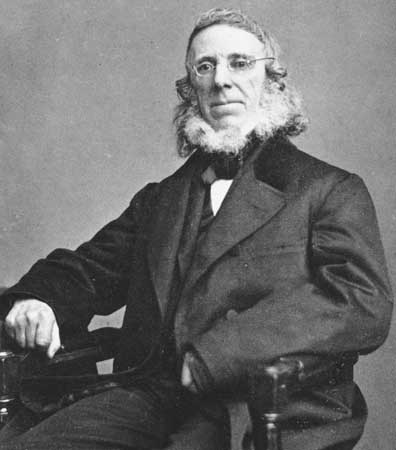

Carnegie Mellon University Established by Andrew Carnegie
sorry about spacing it wouldn't let me move it
Bibliography
2/3/17
Urbanization In-Class Essay
The late nineteenth century was a time of growth and tremendous industrial as well technological change for the world on a global scale. Each year there were new innovative inventions that changed the very nature and quality of life. In America it was considered a time of both crisis and opportunity, or "The turn of the century". For entrepreneurs such as John D. Rockefeller, Andrew Carnegie, and other economic leaders it was a time of prosperity. For the working classes it was considered a time of crisis with the constant changing world around them. Wealthy men like Carnegie saw a way to contribute to society as a whole to improve conditions of the communities around him through philanthropy. Philanthropy contributed to urbanization and industrialization through improving living conditions, building libraries and other buildings, offering educational opportunity, and advancing industrialism to accelerate urbanization during the time.
As many large organization leaders flourished and gained extreme wealth it began to create a gap between the social classes due to unrestrained laissez-faire capitalism, resulting in the uneducated low working class with little opportunity for improvement. These leaders were considered "captains of the industry". Andrew Carnegie, like many other philanthropists that came about during the time, saw his wealth differently. He saw it as a chance to give to others and improve society as a whole contributing through philanthropy. In Carnegie's famous book, The Gospel of Wealth, he states, "Great wealth is a sign of goodness, anyone who has such wealth has the responsibility to uplift those less fortunate." This statement showed that he believed that through philanthropic cause people like himself and Rockefeller can improve the quality of life for the less fortunate. Andrew Carnegie also saw other ways to improve society, such as to establishing learning buildings like libraries, allowing a chance for people to gain knowledge.
During Andrew Carnegie's career he contributed forty million dollars to fund more than 1600 public libraries across the flourishing nation. Offering a place of knowledge and order for people to learn from. Carnegie shows how he believes libraries help society saying, "Libraries are reservoirs of strength, grace and wit, reminder of order, calm and continuity, lakes of mental energy, neither warm nor cold, light nor dark... In any library in the world, I am at home, unselfconscious, still and absorbed." Philanthropists saw providing societies libraries for communities as a chance to allow room for growth throughout the community. Philanthropy during the time also endowed thousands of colleges, hospitals, museums, academies, schools, opera houses, and charities to help communities flourish offering opportunity to the less fortunate.
Many great philanthropists established colleges and academies to advance the educational system to improve the quality of life for many. A philanthropist named Peter Cooper contributed to industrialization by founding the Cooper Union which offered free courses in science, engineering, and art. Thomas Edison, inventor of the light bulb, was one of the many that attended the Cooper Union. Peter summed up his philosophy by saying, "I have endeavored to remember that the object of life is to do good", seeing his wealth like Carnegie as a way to contribute to the slowly growing society. Other philanthropists like Swift and Rockefeller spent the final years giving away fortunes to establish institutions for the betterment of society.
As society was changing rapidly due to urbanization, so was professionalism in many different areas. A modern medical school emerged with the help of philanthropy. American doctors began to travel to Europe to learn of different methods; the emergence of the modern universities in america with the mass educational changes began providing qualified students; along with the cultivation of philanthropy among some rich industrialists provided America with the infrastructure for a new system of advanced medical education, changing the nation as a whole. The new medical technologies changed the lives of many and increased the living conditions of America on a whole new level showing how philanthropy can change society on a much larger scale during the time of rapid urbanization.
Philanthropy contributed to nineteenth century urbanization on many levels, such as through providing opportunites for sufficient education, improving living conditions, establishing institutions, and aiding in the advancement of professionalisms. Through this time of industrial change and urbanization philanthropy has been able to make a noticeable impact on urbanization that in some ways we can see today. Throughout recent history philanthropists have taken these past leaders as an inspiration and made it their mission to change the world as well, wether it be on a small scale or a large scale. Philanthropists today, such as Bill Gates, are still working to improve society showing that through their wealth a change can be made in society just like how it played a role in urbanization.
Carnegie Mellon University Established by Andrew Carnegie
sorry about spacing it wouldn't let me move it
Bibliography
Tuesday, January 17, 2017
Peggy Wallace Kennedy Speech Reflection
Today in the Randolph assembly we had a guest speaker named Peggy Wallace Kennedy who brought her story first hand to myself any my peers. She spoke about her father, Governor George Wallace, who was a big part of the civil rights movements that were taking place in Alabama. This was during the time of MLK's legendary speech "I had a dream". She spoke about how she saw things different from her dad as she grew, as he only saw segregation as the answer. I think it was amazing how Mrs. Kennedy then grew up into politics just like her father only to have a completely different view on things. Her child once had asked why the white people did such horrible things to the colored and that was when she realized she had to change things for her child and for the people around her. Overall I enjoyed listening to her speech in assembly because it shed some light on the way things used to be and how everyone can make a difference. A monumental thing was at the end when both their fathers were on other ends Mrs. Kennedy and Mrs. King held hands together.


Subscribe to:
Comments (Atom)
